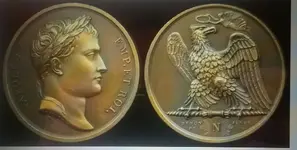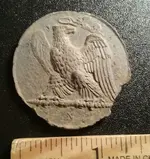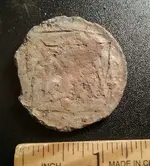Nice little piece of history.
You may be interested in this extract from an article by Luca Einaudi - Joint Centre for History & Economics at Magdalene College & Kings College, University of Cambridge. Although he is talking specifically about the coinage of Napoleon III (the nephew of Napoleon Bonaparte), the 1870s backlash also applies to medals/medallions and to some extent, unfairly, to the Napoleon name in general... whether Napoleon I, II or III.
"The coinage of Napoleon III was subject to one of the largest episodes of political attack, mixed with vandalism, satire and commercial speculation. It began after the defeat of Sedan at the hands of a Prussian-led coalition of German States in September 1870. The Second Empire collapsed and the Third Republic was proclaimed, while the country was invaded. Paris was besieged until it surrendered in the winter of 1871, after the population had come close to starvation. Civil war between the Versaillais and the Communards extended death and destruction further, leaving substantial portions of Paris in ruins after bombing and fire. The enormous war indemnity of 5 billion francs to be paid to Germany and the loss of Alsace Lorraine extended further the feeling of unmitigated catastrophe looming over France in 1870-71.
Napoleon's name was suddenly execrated as the author of national humiliation and his coins were defaced in massive numbers, in what is probably the most acute phenomenon of that kind in European monetary history. His portrait was mutilated by counterstamps with the words "Sedan", "1870", "lâche" (coward), "traitre" (traitor), "infame", "honte" (shame), "bourreau" (executioner), "putain", etc... Napoleon's head was given a Prussian helmet or a chain of slavery attached to his neck, when his face was not replaced by that of Bismarck or of the new German Emperor, who had achieved in the Palace of Versailles the unification of the German Reich so feared by the French.
The nickname forged by Victor Hugo after the Coup d'Etat, "Napoleon the small", was resumed. The French imperial eagle was transformed in an owl, its thunder replaced by human bones and the "Empire français" was rechristened "vampire français". The 80,000 French soldiers taken prisoner after the surrender of Sedan were also part of the indictment. A cigarette was added to the lips of the fallen Emperor as a symbol of his indifference to the plight of his army, as it had been reported that he had been seen smoking on the battlefield. Such a sight would not have shocked anyone in the wars of the twentieth century, but at the time it was considered to be a sign of carelessness; the Emperor was also seen moving around on the front line by carriage and not on horseback, because of his illness. The violence of the damnatio memoriae was such that Napoleon's face could also be transformed into a skull or into the groin of a pig."
One other thing to be aware of is that Napoleon Bonaparte celebratory medals/medallions continued to be struck by the Paris Medal Mint long after their original issue, using the same dies. The re-strikes come in a wider variety of metals and plating finishes. The exact number of variations and issue dates is not known because the official records were erased on the orders of King Louis XVIII and we only have complete records from later times; generally post-1879, and this medallion was certainly re-struck after that date.
The original 1807 medal was commissioned to be struck in silver and had a plain edge. It may have been struck in other metals. The later re-strikes from the original dies are generally in bronze (sometimes silver plated) and as the information from the ‘vcoins’ website suggests, most usually have the word “bronze” stamped into the edge in capital letters (it’s the same word in French and English). The original strikes are the most valuable/desirable, but obviously not when in poor condition.
 3
3 3
3




